Analytical Prediction of the Distortional Buckling Loads for Cold-Formed Channel Beams with Edge-Stiffened Rectangular Web Openings
Abstract
1. Introduction
2. Analytical Model
2.1. Critical Load for Pure Distortional Buckling of Nonperforated Lipped Channel Beams
2.2. for a Simply Supported Plate with Edge-Stiffened Rectangular Openings on the Midspan
- (a)
- The geometric center of the hole coincides with that of the web as shown in Figure 3;
- (b)
- The web plate of the C-section in flexure is treated as a beam simply supported at one end and fixed at the other end (see Figure 4);
- (c)
- The derivation of the formula is within the theory of small deformation, so the higher-order terms (above the second order) can be ignored;
- (d)
- The middle surface of the hole stiffeners, which is initially perpendicular to the middle surface of the web, always stays perpendicular to the web midsurface during the deflection of the web plate.
2.3. Critical Load for Pure Distortional Buckling of Lipped Channel Beams with Edge-Stiffened Holes
3. Numerical Analysis
3.1. General
3.2. FE Modeling
3.3. Boundary Conditions
3.4. Validation of the Analytical Model
4. Effect of Edge-Stiffener Length on the Critical Moment of Distortional Buckling
5. Conclusions
- (a)
- The existence of edge stiffeners will not change the overall trend of elastic buckling.
- (b)
- When the enhancement of edge stiffeners dominates the change in critical distortional moments, the critical moment of distortional buckling increases as increases; on the contrary, the critical moment of global buckling decreases as increases.
- (c)
- In the distortional buckling mode, the critical distortional moments of beams with edge-stiffened holes generally increase as increases, but the enhancement effect of edge stiffeners declines when exceeds the threshold of about 0.05.
- (d)
- The critical distortional moments of beams with edge-stiffened holes increase as increases when the value reaches the threshold of about 0.03, which means the enhancement of edge stiffeners dominates the change of critical distortional moments in this situation.
6. Recommendation
Author Contributions
Funding
Data Availability Statement
Acknowledgments
Conflicts of Interest
Abbreviations
| A | = | Cross-sectional area of flange–lip system |
| b | = | plate width |
| c | = | depth of lip stiffener |
| D | = | plate flexural rigidity per unit width |
| E | = | Young’s modulus |
| e | = | edge stiffener length |
| h | = | depth of web |
| hhole | = | depth of web hole |
| Iy, Iz | = | second moments of area of flange–lip system about the y- and z-axes |
| Ig | = | second moment of the gross area of lipped channel section without holes |
| Iyz | = | product second moment of area of flange–lip system about the y- and z-` |
| yc, zc | = | y, z distances of centroid from the flange–web junction (see Figure 2) |
| J | = | St. Venant torsional constant |
| L | = | beam length |
| Lcrd | = | distortional buckling half wavelength of beam |
| Lhole | = | length of web hole |
| Mcr | = | critical elastic distortional buckling moment |
| t | = | thickness |
| ν | = | Poisson’s ratio |
Appendix A. Buckling Stress of Web Plates with Folds
References
- AISI S100-16; North American Specification for the Design of Cold-Formed Steel Structural Members. American Iron and Steel Institute(AISI): Washington, DC, USA, 2016.
- EN1993-1-3; Design of Steel Structures. Part 1–3: General Rules- Supplementary Rules for Cold-Formed Members and Sheeting. BSI: Brussels, Belgium, 2006.
- AS/NZS 4600:2018; Cold-Formed Steel Structures. Australia/New Zealand Standard (AS/NZS): Wellington, New Zealand, 2018.
- Lau, S.C.W.; Hancock, G.J. Distortional Buckling Formulas for Channel Columns. J. Struct. Eng. 1987, 113, 1063–1078. [Google Scholar] [CrossRef]
- Hancock, G.J. Design for distortional buckling of flexural members. Thin-Walled Struct. 1997, 27, 3–12. [Google Scholar] [CrossRef]
- Li, L.-Y.; Chen, J.-K. An analytical model for analysing distortional buckling of cold formed steel sections. Thin-Walled Struct. 2008, 46, 1430–1436. [Google Scholar] [CrossRef]
- Schafer, B.W.; Pekoz, T. Laterally braced cold-formed steel flexural members with edge stiffened flanges. J. Struct. Eng. 1999, 125, 118–127. [Google Scholar] [CrossRef]
- Schafer, B.W. Local, Distortional, and Euler Buckling of Thin-Walled Columns. J. Struct. Eng. 2002, 128, 289–299. [Google Scholar] [CrossRef]
- Liu, Z.; Yang, Y.; Zhou, X.; He, Z. Unified formulae for critical load and unified DSM expressions for pinned-end and fixed-end columns exhibiting pure distortional buckling. Thin-Walled Struct. 2020, 151, 106746. [Google Scholar] [CrossRef]
- Zhou, X.; Liu, Z.; He, Z. General distortional buckling formulae for both fixed-ended and pinned-ended C-section columns. Thin-Walled Struct. 2015, 94, 603–611. [Google Scholar] [CrossRef]
- Yu, N.-T.; Kim, B.; Yuan, W.-B.; Li, L.-Y.; Yu, F. An analytical solution of distortional buckling resistance of cold-formed steel channel-section beams with web openings. Thin-Walled Struct. 2019, 135, 446–452. [Google Scholar] [CrossRef]
- Yu, N.-T.; Kim, B.; Li, L.-Y.; Hong, W.-J.; Yuan, W.-B. Distortional buckling of perforated cold-formed steel beams subject to uniformly distributed transverse loads. Thin-Walled Struct. 2020, 148, 106569. [Google Scholar] [CrossRef]
- Yu, N.-T.; Kim, B.; Huang, X.-H.; Yuan, W.-B.; Ye, R.; Wu, L.; Le, J.-J. Analytical solution for flange/web distortional buckling of cold-formed steel beams with circular web perforations. Mech. Adv. Mater. Struct. 2021, 29, 3463–3473. [Google Scholar] [CrossRef]
- Yuan, W.-B.; Yu, N.-T.; Li, L.-Y. Distortional buckling of perforated cold-formed steel channel-section beams with circular holes in web. Int. J. Mech. Sci. 2017, 126, 255–260. [Google Scholar] [CrossRef]
- Cardosoa, D.C.T.; de Salles, G.C.; Batista, E.d.M.; Gonçalves, P.B. Explicit equations for distortional buckling of cold-formed steel lipped channel columns. Thin-Walled Struct. 2017, 119, 925–933. [Google Scholar] [CrossRef]
- Moen, C.D. Direct Strength Design of Cold-Formed Steel Members with Perforations. Ph.D. Thesis, Johns Hopkins University, Baltimore, MD, USA, 2008. [Google Scholar]
- Moen, C.D.; Schafer, B.W. Experiments on cold-formed steel columns with holes. Thin-Walled Struct. 2008, 46, 1164–1182. [Google Scholar] [CrossRef]
- Moen, C.D.; Schafer, B.W. Extending Direct Strength Design to Cold-Formed Steel Beams with Holes. In Proceedings of the Twentieth International Specialty Conference on Cold-Formed Steel Structures, St. Louis, MO, USA, 3–4, November 2010. [Google Scholar]
- Moen, C.D.; Schafer, B.W. Elastic buckling of cold-formed steel columns and beams with holes. Eng. Struct. 2009, 31, 2812–2824. [Google Scholar] [CrossRef]
- Moen, C.D.; Schafer, B.W. Elastic buckling of thin plates with holes in compression or bending. Thin-Walled Struct. 2009, 47, 1597–1607. [Google Scholar] [CrossRef]
- Moen, C.D.; Schafer, B.W. Direct Strength Method for Design of Cold-Formed Steel Columns with Holes. Eng. Struct. 2011, 137, 559–570. [Google Scholar] [CrossRef]
- Moen, C.D.; Schudlich, A.; Heyden, A. Experiments on cold-formed steel C-section joists with unstiffened web holes. Struct. Eng. 2013, 139, 695–704. [Google Scholar] [CrossRef]
- Chen, B.; Roy, K.; Uzzaman, A.; Raftery, G.M.; Nash, D.; Clifton, G.C.; Pouladi, P.; Lim, J.B. Effects of edge-stiffened web openings on the behaviour of cold-formed steel channel sections under compression. Thin-Walled Struct. 2019, 144, 106307. [Google Scholar] [CrossRef]
- Chen, B.; Roy, K.; Uzzaman, A.; Lim, J.B.P. Moment capacity of cold-formed channel beams with edge-stiffened web holes, un-stiffened web holes and plain webs. Thin-Walled Struct. 2020, 157, 107070. [Google Scholar] [CrossRef]
- Chen, B.; Roy, K.; Uzzaman, A.; Raftery, G.M.; Lim, J.B.P. Parametric study and simplified design equations for cold-formed steel channels with edge-stiffened holes under axial compression. J. Constr. Steel Res. 2020, 172, 106161. [Google Scholar] [CrossRef]
- Chen, B.; Krishanu, R.; Fang, Z.; Uzzaman, A.; Pham, C.H.; Raftery, G.M.; Lim, J.B.P. Shear Capacity of Cold-Formed Steel Channels with Edge-Stiffened Web Holes, Unstiffened Web Holes, and Plain Webs. J. Struct. Eng. 2022, 148, 04021268. [Google Scholar] [CrossRef]
- Chen, B.; Krishanu, R.; Fang, Z.; Uzzaman, A.; Chi, Y.; Lim, J.B.P. Web crippling capacity of fastened cold-formed steel channels with edge-stiffened web holes, un-stiffened web holes and plain webs under two-flange loading. Thin-Walled Struct. 2021, 163, 10766. [Google Scholar] [CrossRef]
- Yu, C. Cold-formed steel flexural member with edge stiffened holes: Behavior, optimization, and design. J. Constr. Steel Res. 2012, 71, 210–218. [Google Scholar] [CrossRef]
- Kanthasamy, E.; Thirunavukkarasu, K.; Poologanathan, K.; Gatheeshgar, P.; Todhunter, S.; Suntharalingam, T.; Ishqy, M.F.M. Shear behaviour of doubly symmetric rectangular hollow flange beam with circular edge-stiffened openings. Eng. Struct. 2022, 250, 113366. [Google Scholar] [CrossRef]
- Moen, C.; Yu, C. Elastic Buckling of Thin-Walled Structural Components with Edge-Stiffened Holes. In Proceedings of the 51st AIAA/ASME/ASCE/AHS/ASC Structures, Structural Dynamics, and Materials Conference 18th, Orlando, FL, USA, 12–15 April 2010. [Google Scholar]
- Grey, C.N.; Moen, C.D. Elastic Buckling Simplified Methods for Cold-Formed Columns and Beams with Edge-Stiffened Holes. In Proceedings of the Annual Stability Conference Structural Stability Research Council, Pittsburgh, PA, USA, 10–14 May 2011. [Google Scholar]
- Fang, Z.; Roya, K.; Chen, B.; Sham, C.-W.; Hajirasouliha, I.; Lim, J.B.P. Deep learning-based procedure for structural design of cold-formed steel channel sections with edge-stiffened and un-stiffened holes under axial compression. Thin-Walled Struct. 2021, 166, 108076. [Google Scholar] [CrossRef]
- Dai, Y.; Roy, K.; Fang, Z.; Chen, B.; Raftery, G.M.; Lim, J.B.P. A novel machine learning model to predict the moment capacity of cold-formed steel channel beams with edge-stiffened and un-stiffened web holes. J. Build. Eng. 2022, 53, 104592. [Google Scholar] [CrossRef]
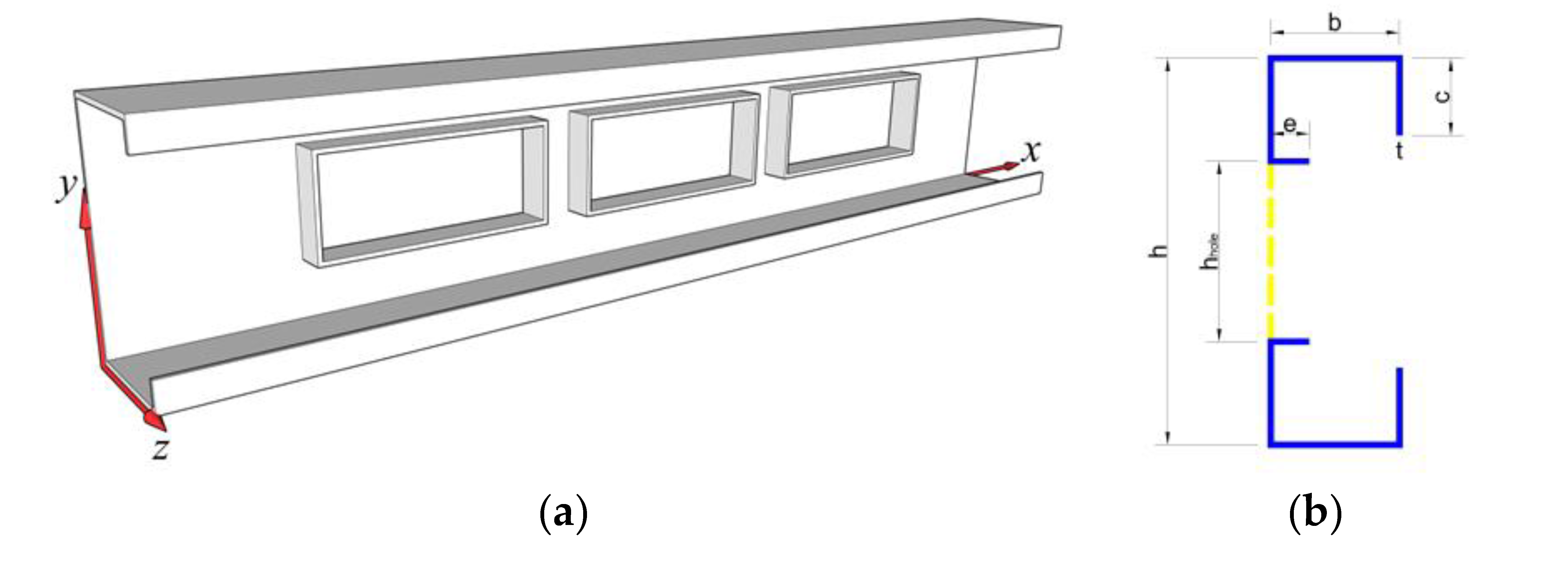
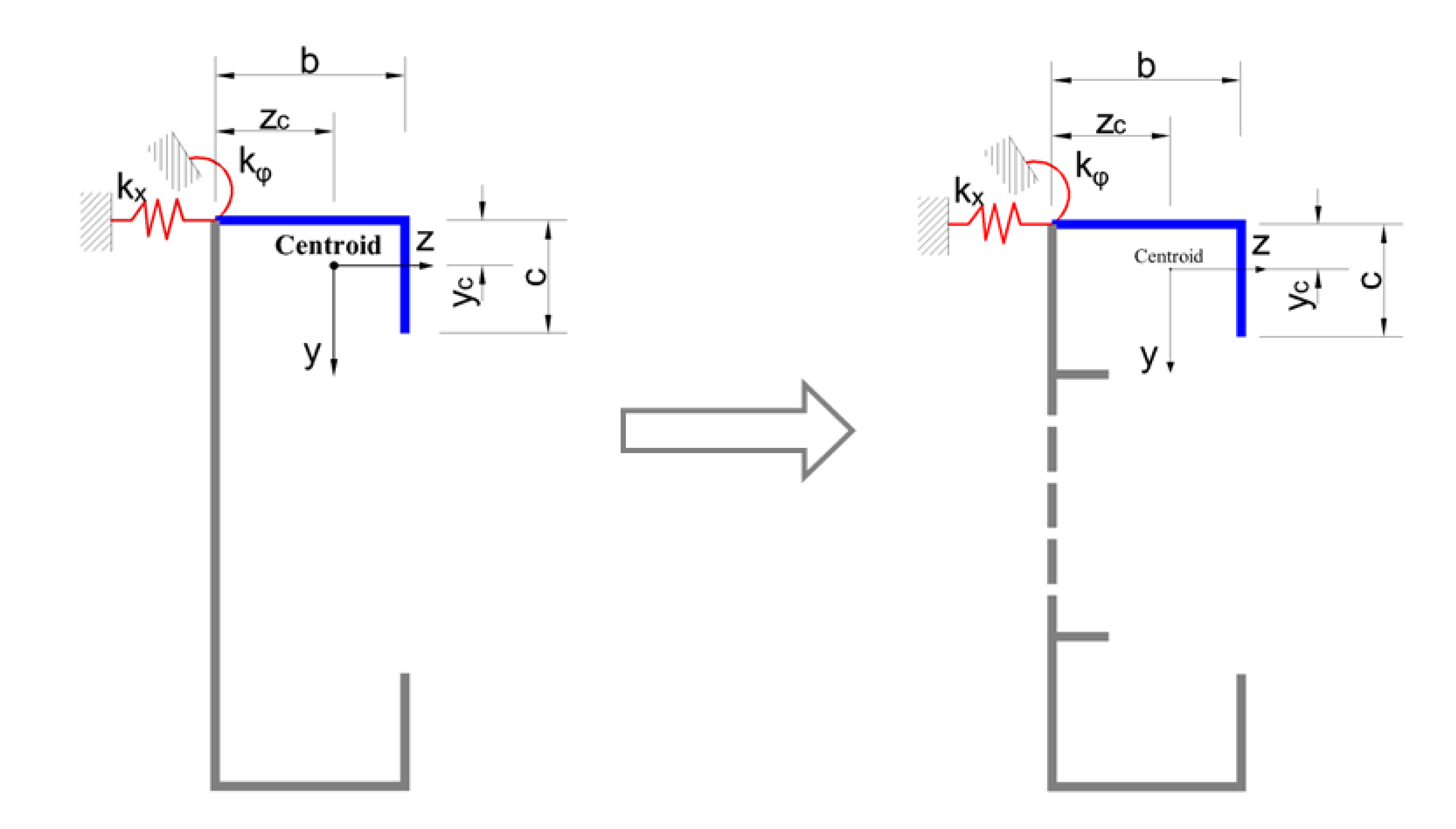
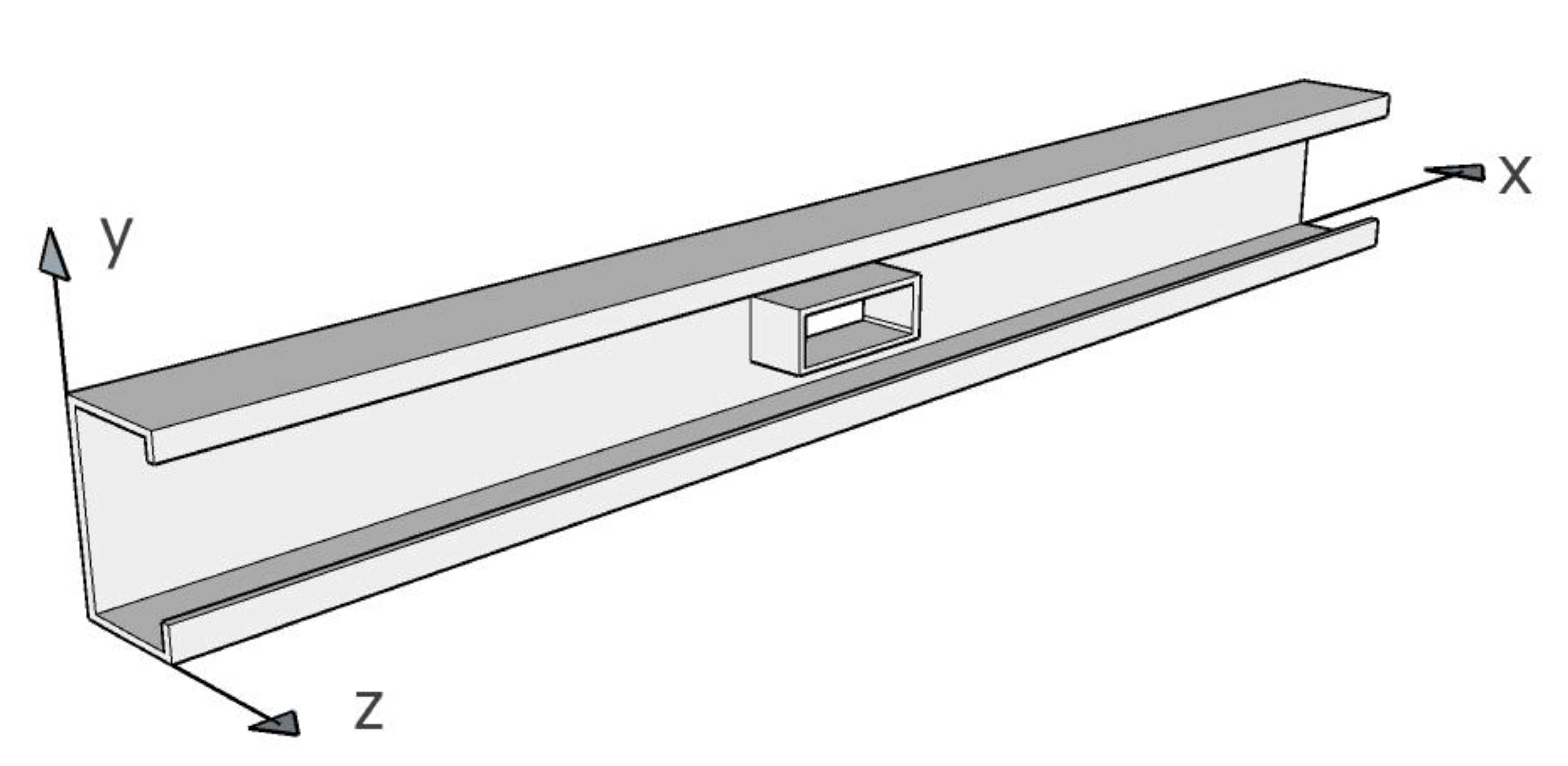
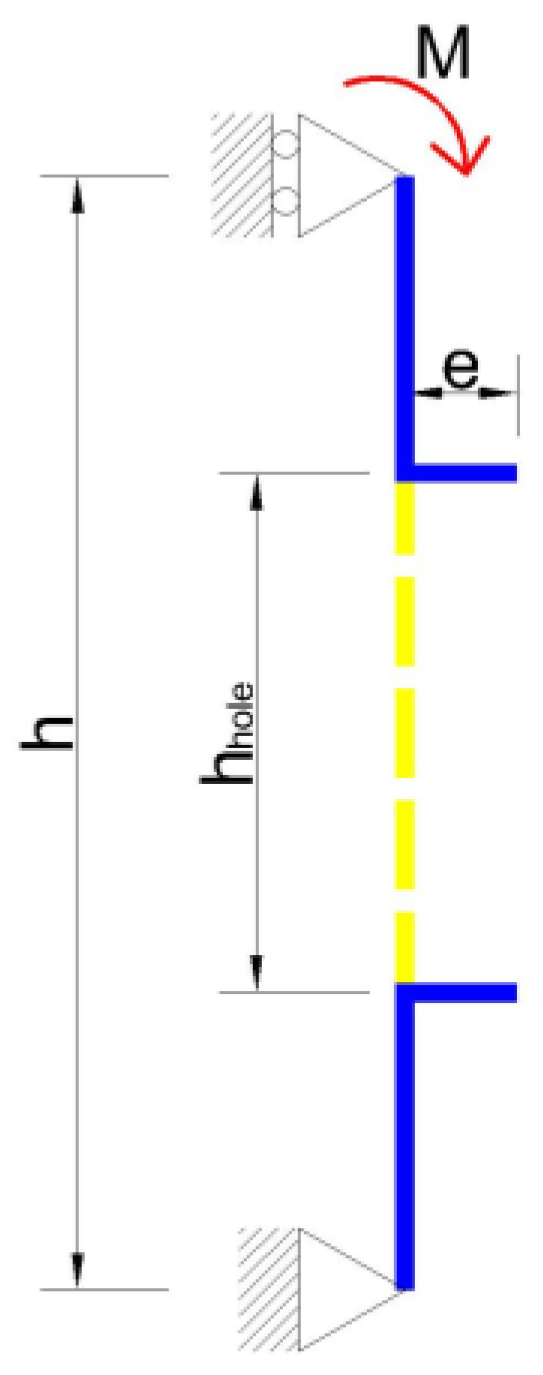
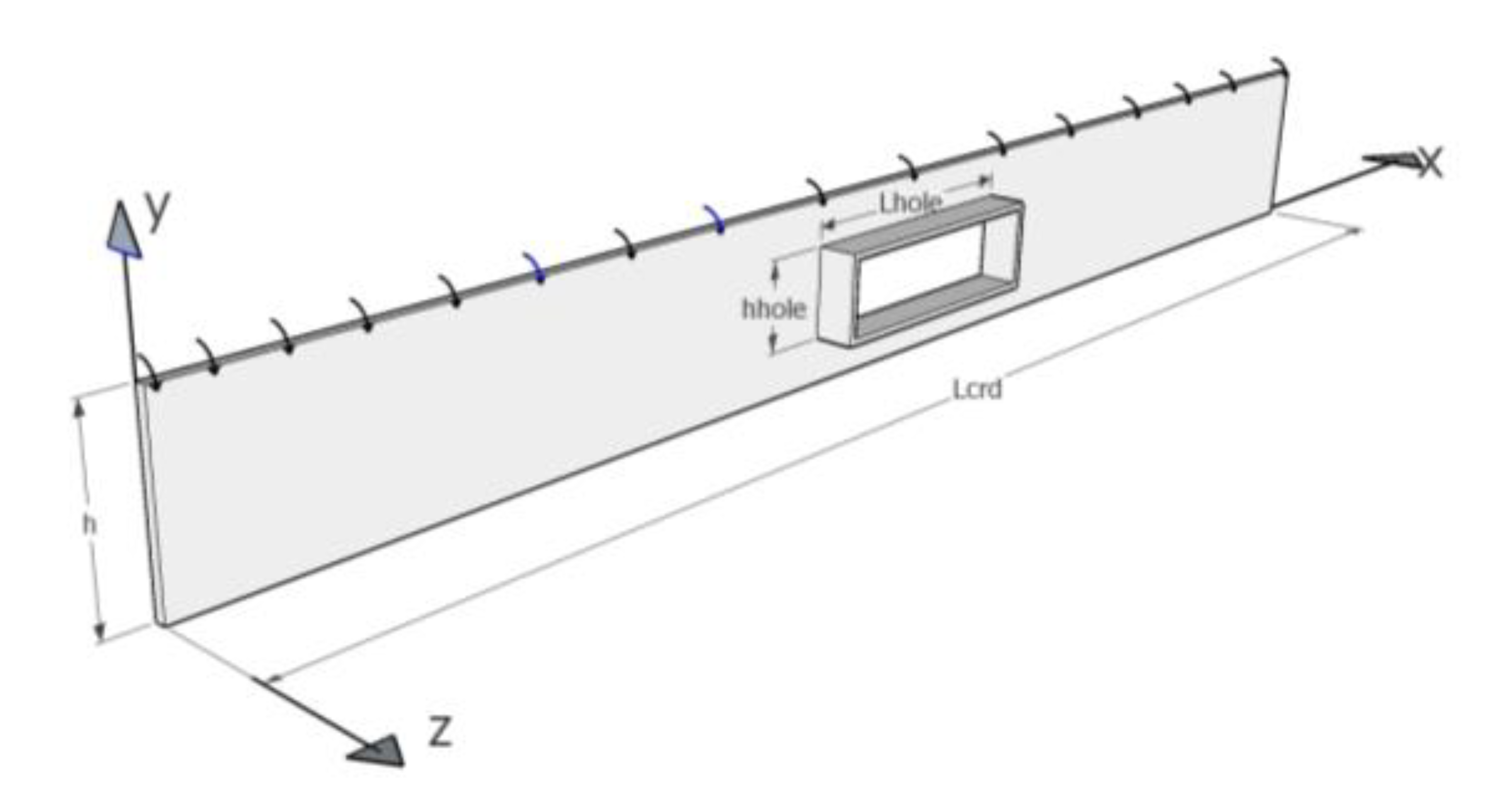
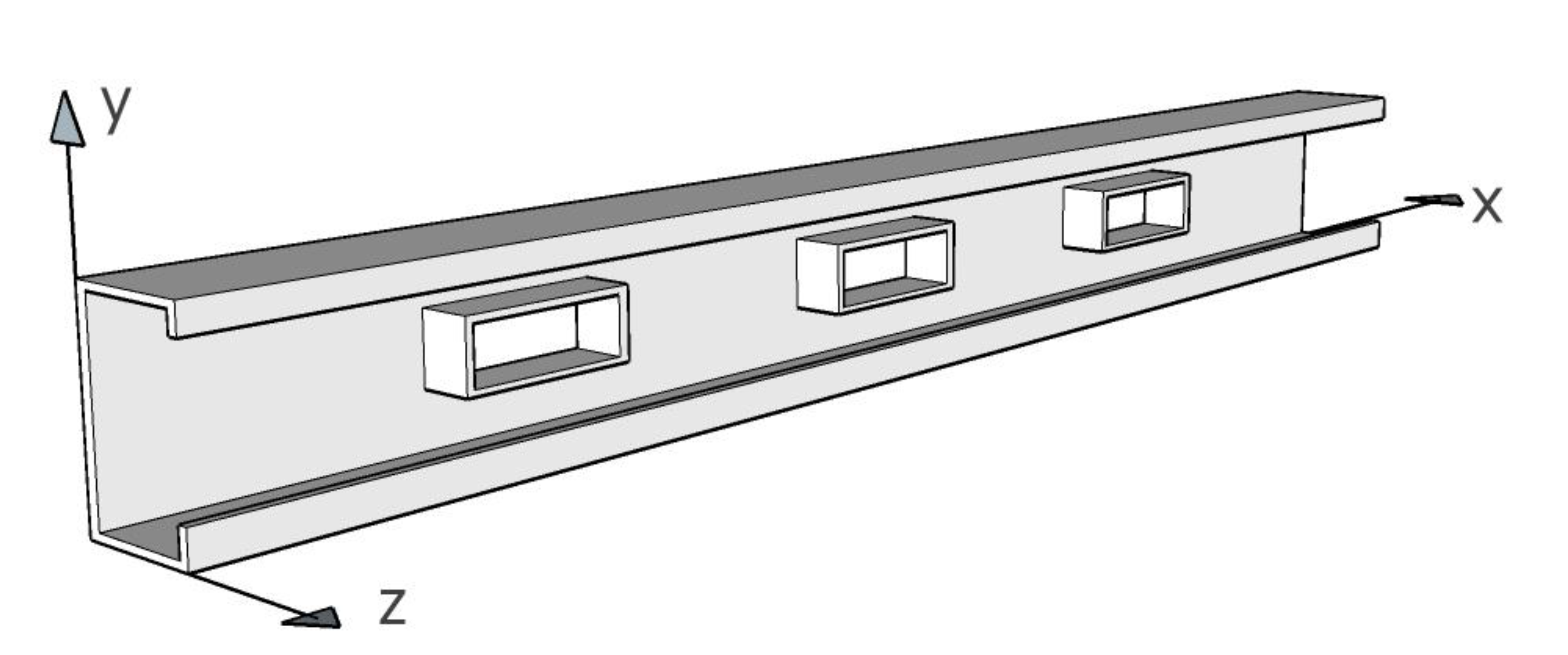
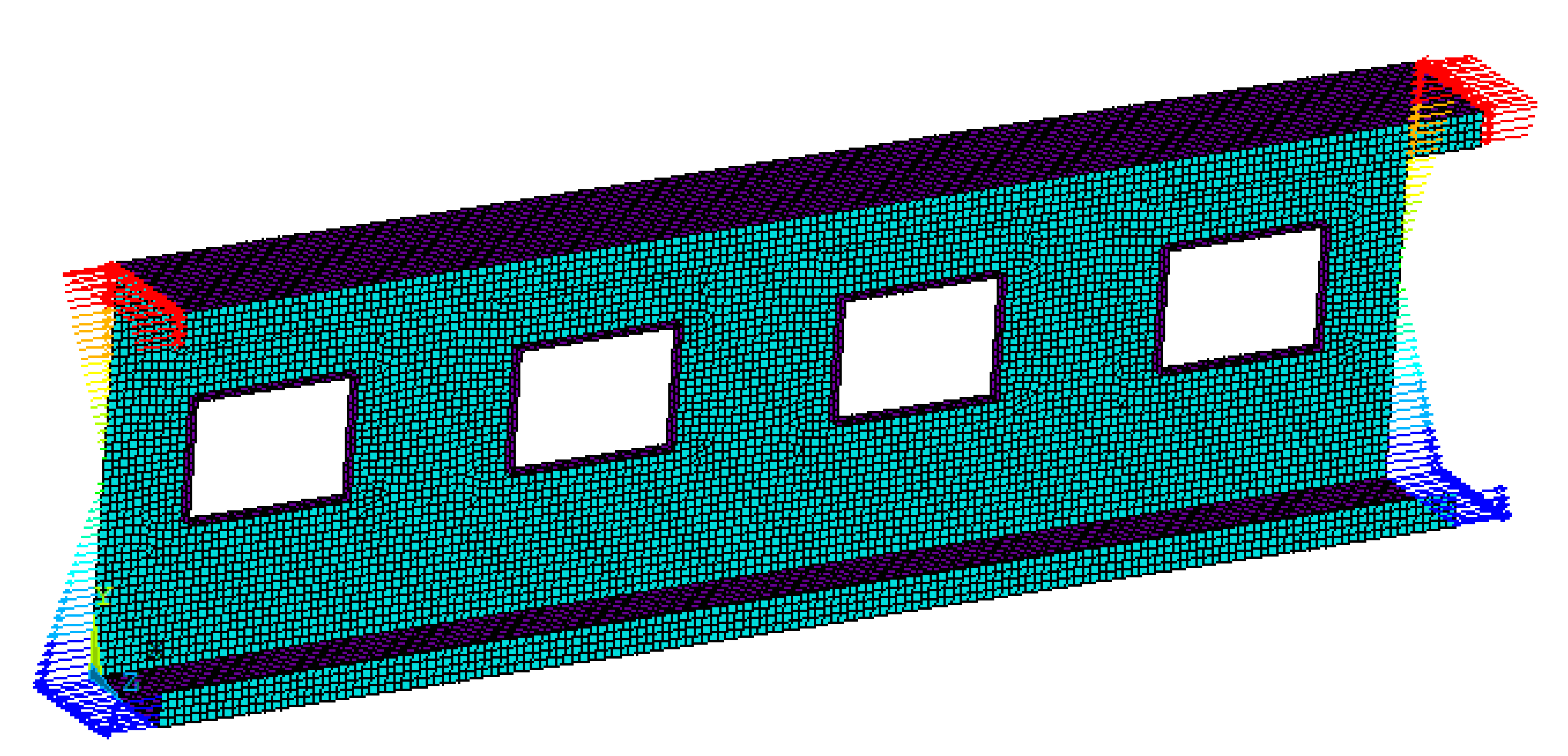
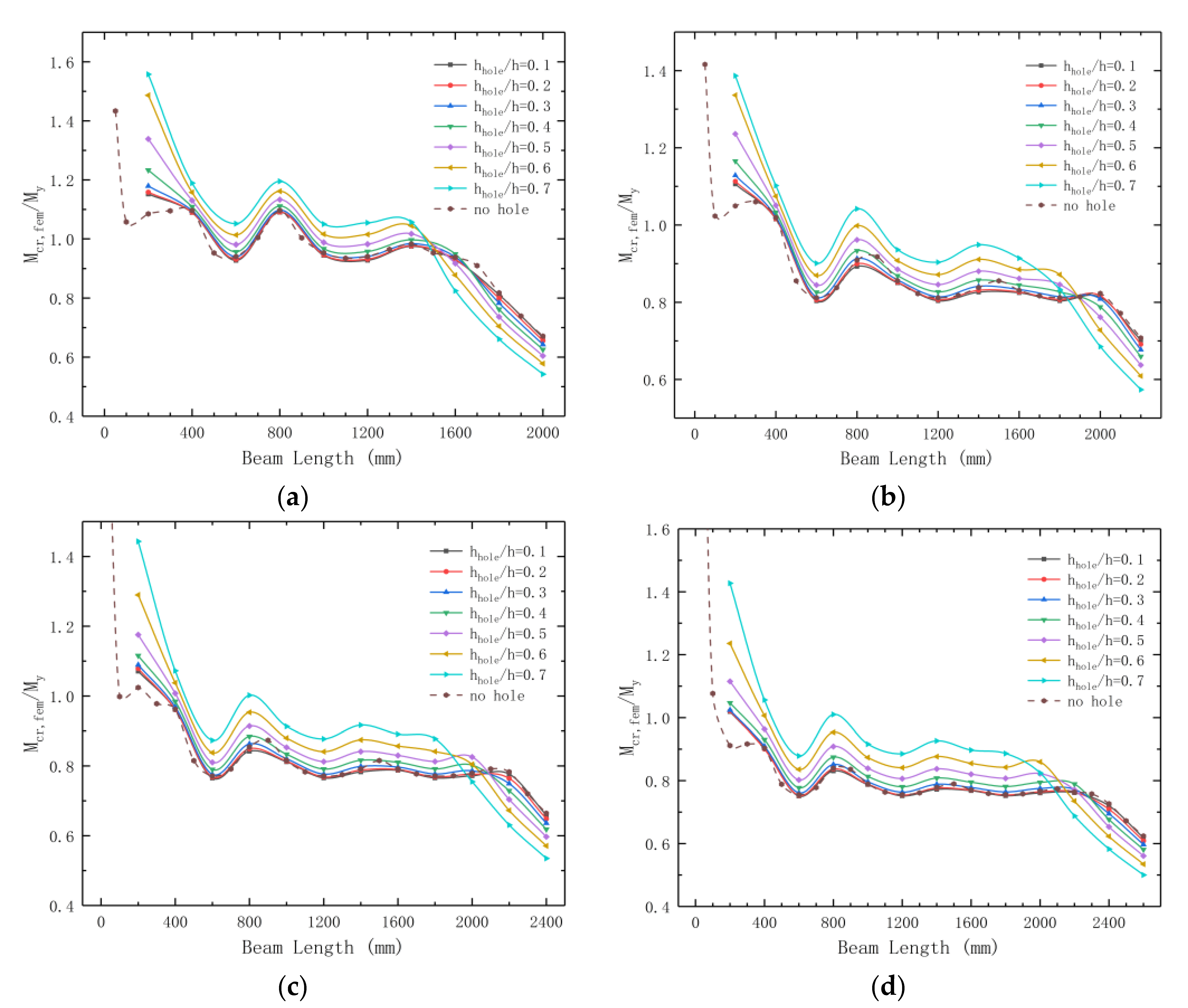
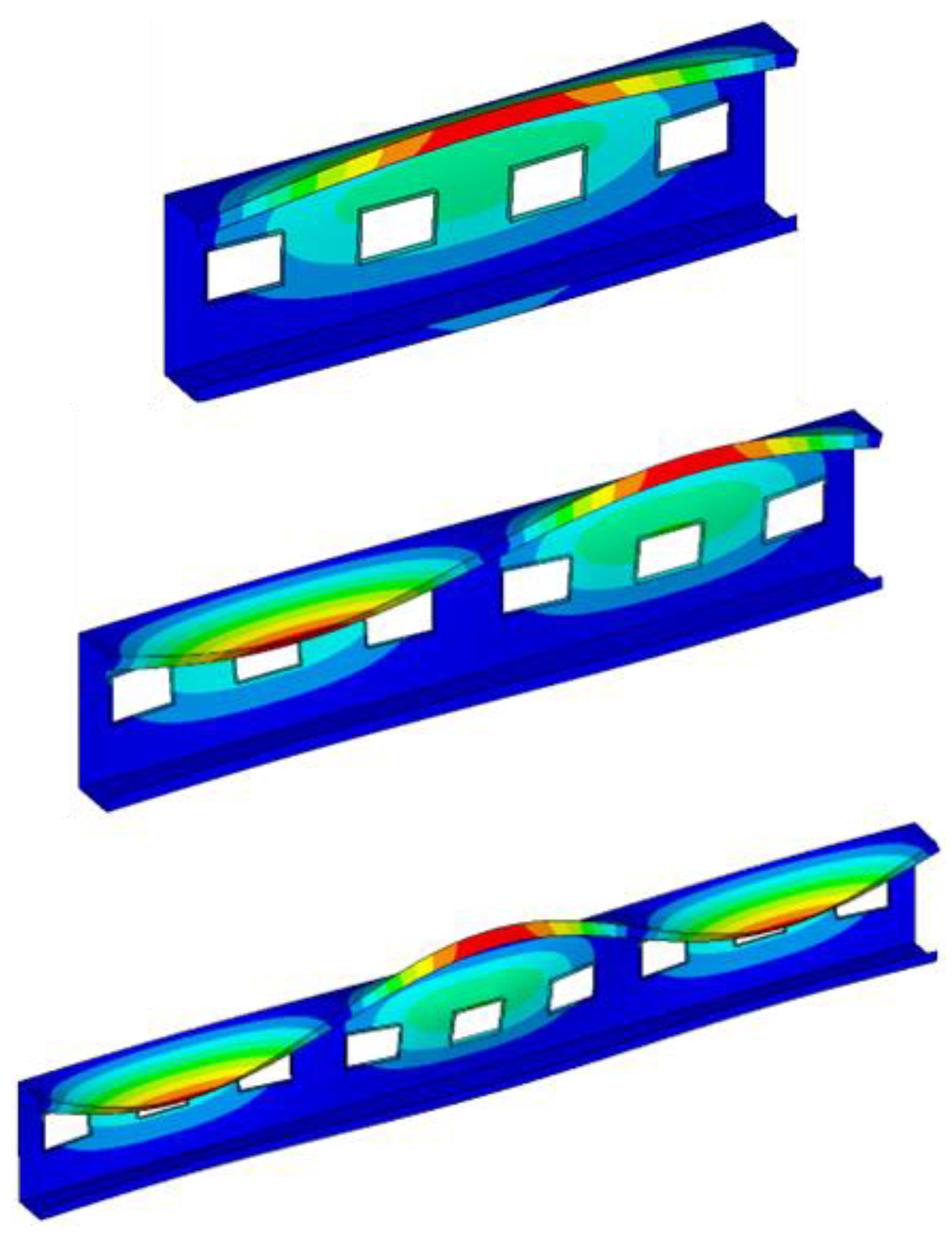
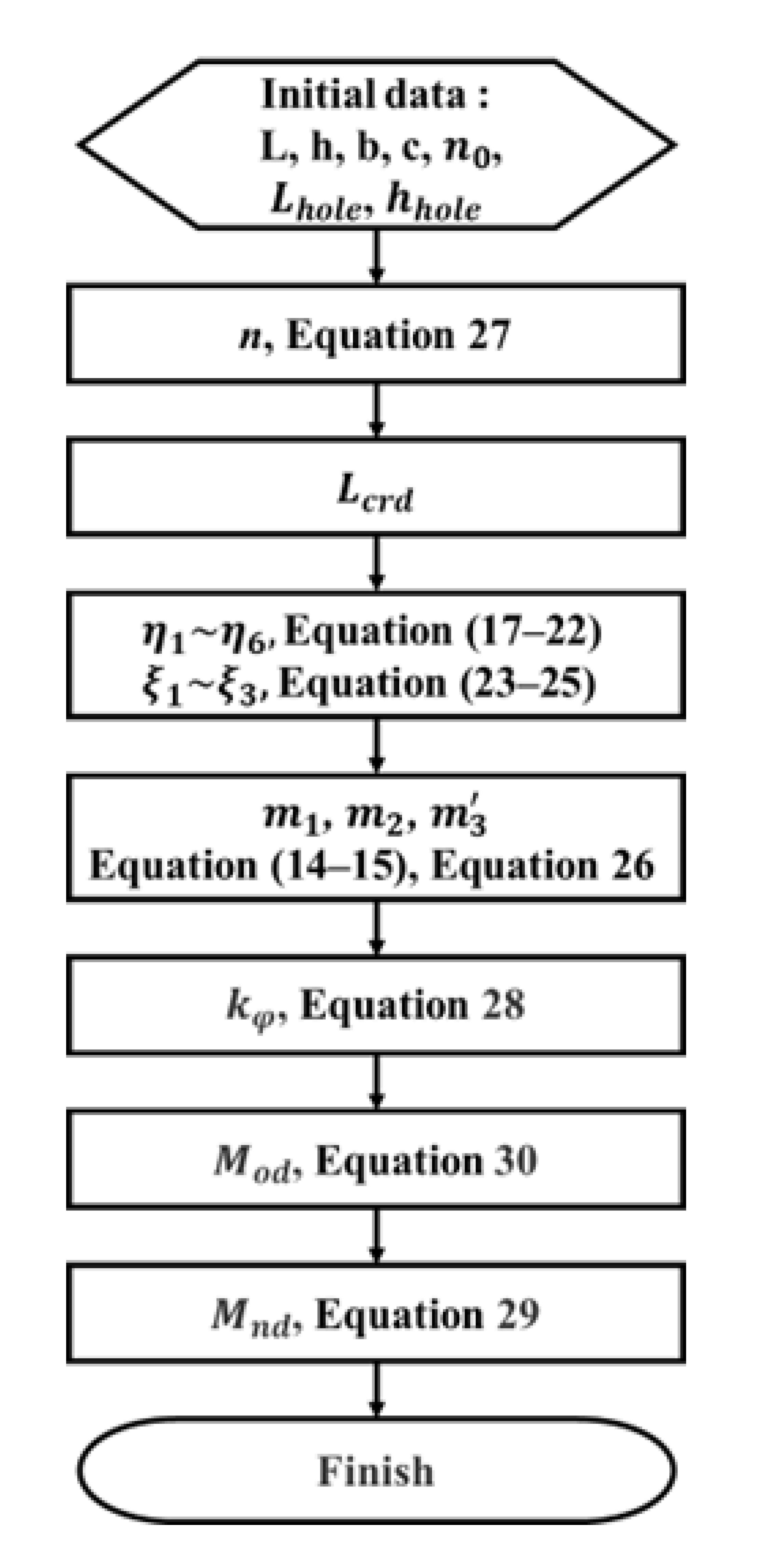
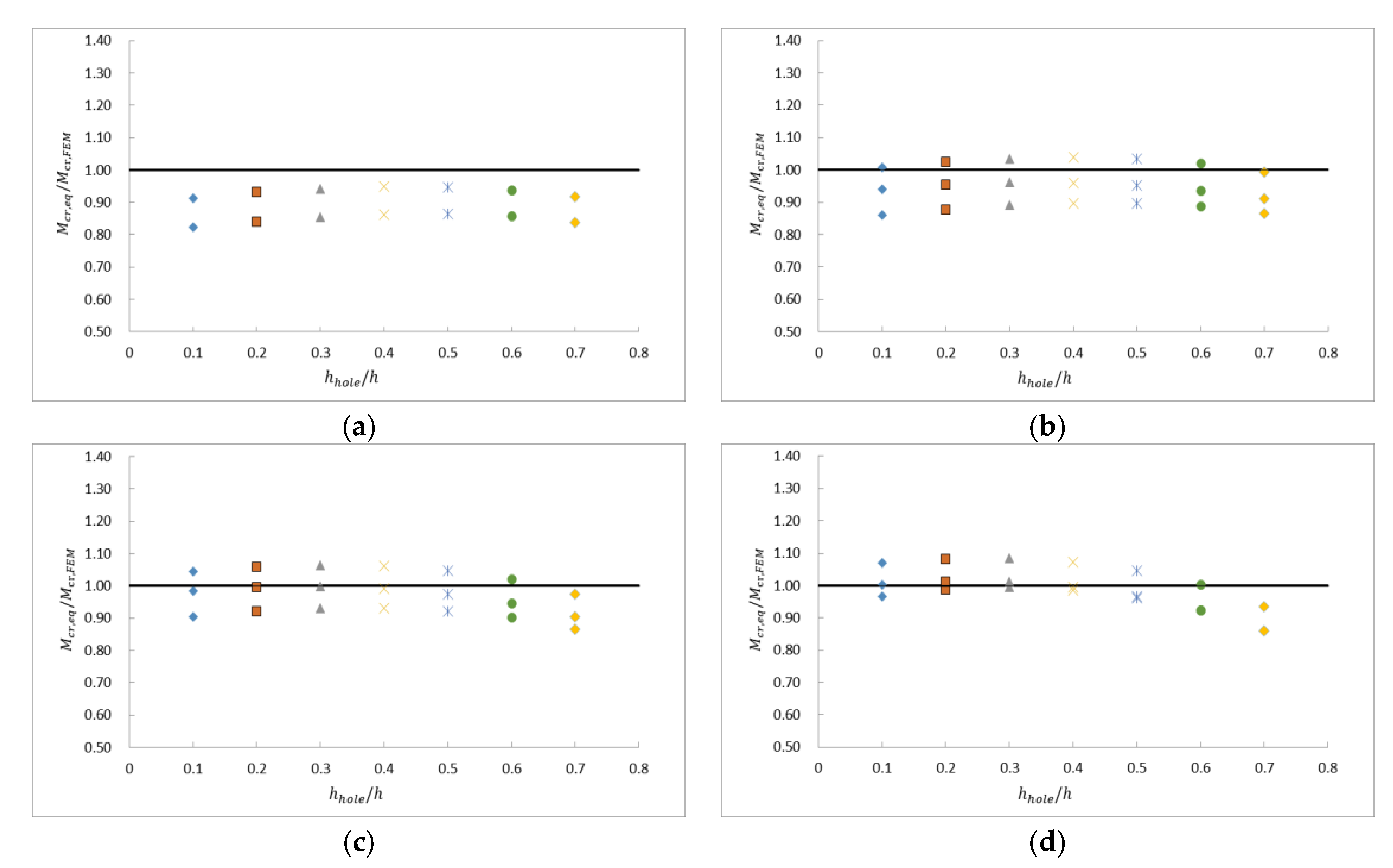

| Sections | h/mm | b/mm | c/mm | t/mm |
|---|---|---|---|---|
| A | 180 | 60 | 20 | 2.0 |
| B | 200 | 70 | 20 | 2.2 |
| C | 240 | 75 | 20 | 2.5 |
| D | 300 | 80 | 20 | 3.0 |
Disclaimer/Publisher’s Note: The statements, opinions and data contained in all publications are solely those of the individual author(s) and contributor(s) and not of MDPI and/or the editor(s). MDPI and/or the editor(s) disclaim responsibility for any injury to people or property resulting from any ideas, methods, instructions or products referred to in the content. |
© 2022 by the authors. Licensee MDPI, Basel, Switzerland. This article is an open access article distributed under the terms and conditions of the Creative Commons Attribution (CC BY) license (https://creativecommons.org/licenses/by/4.0/).
Share and Cite
Liu, C.; Duan, L. Analytical Prediction of the Distortional Buckling Loads for Cold-Formed Channel Beams with Edge-Stiffened Rectangular Web Openings. Buildings 2023, 13, 101. https://doi.org/10.3390/buildings13010101
Liu C, Duan L. Analytical Prediction of the Distortional Buckling Loads for Cold-Formed Channel Beams with Edge-Stiffened Rectangular Web Openings. Buildings. 2023; 13(1):101. https://doi.org/10.3390/buildings13010101
Chicago/Turabian StyleLiu, Can, and Liping Duan. 2023. "Analytical Prediction of the Distortional Buckling Loads for Cold-Formed Channel Beams with Edge-Stiffened Rectangular Web Openings" Buildings 13, no. 1: 101. https://doi.org/10.3390/buildings13010101
APA StyleLiu, C., & Duan, L. (2023). Analytical Prediction of the Distortional Buckling Loads for Cold-Formed Channel Beams with Edge-Stiffened Rectangular Web Openings. Buildings, 13(1), 101. https://doi.org/10.3390/buildings13010101






